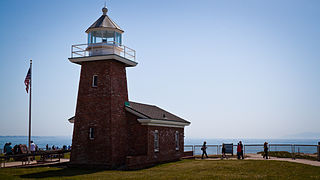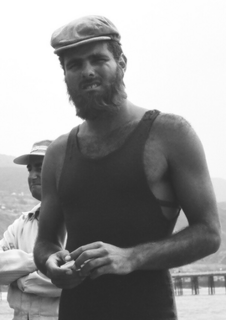
Surfing is a surface water pastime in which the wave rider, referred to as a surfer, rides on the forward part, or face, of a moving wave, which usually carries the surfer towards the shore. Waves suitable for surfing are primarily found in the ocean, but can also be found in lakes or rivers in the form of a standing wave or tidal bore. However, surfers can also utilize artificial waves such as those from boat wakes and the waves created in artificial wave pools.

A surfboard is a narrow plank used in surfing. Surfboards are relatively light, but are strong enough to support an individual standing on them while riding an ocean wave. They were invented in ancient Hawaii, where they were known as papa he'e nalu in the Hawaiian language, they were usually made of wood from local trees, such as koa, and were often over 460 cm (15 ft) in length and extremely heavy. Major advances over the years include the addition of one or more fins (skegs) on the bottom rear of the board to improve directional stability, and numerous improvements in materials and shape.

Bethany Meilani Hamilton is an American professional surfer who survived a 2003 shark attack in which her left arm was bitten off and who ultimately returned to professional surfing. She wrote about her experience in the 2004 autobiography Soul Surfer: A True Story of Faith, Family, and Fighting to Get Back on the Board. In April 2011, the feature film Soul Surfer was released. She also has a 2019 movie, Unstoppable, where she shows the struggles and happiness of her family.
Tom Morey, also known by the moniker "Y", is a musician, engineer, shaper, and surfer responsible for several technological innovations that have heavily influenced modern developments in surfing equipment design.
Greg Noll, nicknamed "Da Bull" by Phil Edwards in reference to his physique and way of "charging" down the face of a wave, is an American pioneer of big wave surfing and is also acknowledged as a prominent longboard shaper. Noll was a member of a US lifeguard team that introduced malibu boards to Australia around the time of the 1956 Melbourne Olympic Games. Noll also produced a "legendary" series of 5 Search for Surf movies.

Surf culture includes the people, language, fashion, and lifestyle surrounding the sport of surfing. The history of surfing began with the ancient Polynesians. That initial culture directly influenced modern surfing, which began to flourish and evolve in the early 20th century, with its popularity peaking during the 1950s and 1960s. It has affected music, fashion, literature, film, art, and youth jargon in popular culture. The number of surfers throughout the world continues to increase as the culture spreads.

The Santa Cruz Surfing Museum is a museum which was established in May 1986 to document the history of surfing. With collections dating back to the earliest years of surfing on mainland United States, the museum houses a historical account of surfing in Santa Cruz, California.
The riding of waves has likely existed since humans began swimming in the ocean. In this sense, bodysurfing is the oldest type of wave-catching. Archaeological evidence suggests that ancient cultures of Peru surfed on reed watercraft for fishing and recreation up to five thousand years ago. Standing up on what is now called a surfboard is a relatively recent innovation developed by the Polynesians. The influences for modern surfing can be directly traced to the surfers of pre-contact Hawaii.

Paddleboarding participants are propelled by a swimming motion using their arms while lying or kneeling on a paddleboard or surfboard in the ocean. This article refers to traditional prone or kneeling paddleboarding. A derivative of paddleboarding is stand up paddleboarding also called stand up paddle surfing. Paddleboarding is usually performed in the open ocean, with the participant paddling and surfing unbroken swells to cross between islands or journey from one coastal area to another. Champion paddlers can stroke for hours and a 20-mile (32 km) race is only a warm-up for well-trained paddlers.
Bruce Jones was a founding pioneer in the surfboard shaping industry.

John Lamb is an American artist and entrepreneur.
Scott Brewster Dillon was an Australian surfer.

Miklos Sandor Dora III, known professionally as Miki Dora was a noted surfer of the 1950s and 1960s in Malibu, California.

Moonlight State Beach is a state beach in Encinitas, California. It is located one fifth of a mile beyond the point where Encinitas Boulevard turns into B Street after it crosses Highway 101.

Soul Surfer is a 2011 American biographical drama film directed by Sean McNamara, based on the 2004 autobiography Soul Surfer: A True Story of Faith, Family, and Fighting to Get Back on the Board by Bethany Hamilton about her life as a surfer after a horrific shark attack and her recovery. The film stars AnnaSophia Robb, Helen Hunt, Dennis Quaid, and Lorraine Nicholson with Carrie Underwood, Kevin Sorbo, Sonya Balmores, Branscombe Richmond, and Craig T. Nelson.
Surfing Florida is an exhibition created in cooperation between the University of Central Florida and Florida Atlantic University chronicling the history of surfing and surf culture in Florida. The exhibition combines photographic works and displays, as well as vintage surf materials, in order to detail Florida's influence on American surfing and vice versa.
Sean Mattison is an American former professional surfer and current professional surf coach and mastermind behind Kelly Slater's "nubster". A fifth fin that was created by Mattison that some critics say helped Kelly Slater win his 11th ASP World Championship. Mattison also is the designer of his own alternative high performance surfboards and surfboard fins named Von-Sol.
Donald Moke Takayama was an American professional surfer and surfboard shaper. Originally a longboard surfer, Takayama won the Master's division of the United States Surfing Champions in 1971, 1972 and 1973. Hawaiian born, Takayama learned to surf at Waikiki Beach and moved to California in the mid-1950s. Takayama died of complications from heart surgery; he is survived by his wife and four daughters.

Surfing in the United States is a popular hobby in coastal areas, and more recently due to the invention of wave pools, inland regions of the country. It contributes to a lifestyle and culture in which millions participate and which millions more have an interest. USA surfing is the governing body for the sport of surfing in the United States, with surf leagues such as the World Surf League available in the country. Surfing can be traced back to 17th Century Hawaii and has evolved over time into the professional sport it is today, with surfing being included for the first time in the 2020 Summer Olympics in Tokyo.

The Museum of British Surfing, in Braunton in the English county of Devon, contains exhibits relating to the history of surfing in the United Kingdom.















